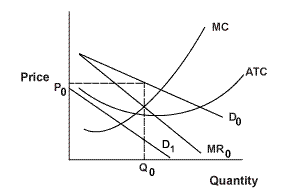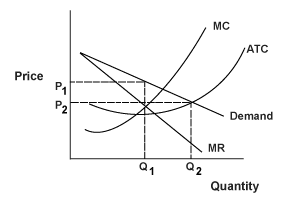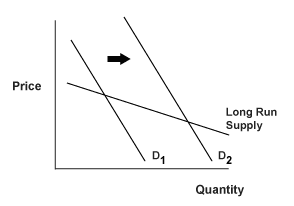The Firm vs. the Industry's Short-Run Supply Curve
A company will continue to produce output until marginal revenue (MR) is equal to marginal cost (MC).
In other words, the condition for maximum profit occurs where:MR = MC
Another condition for profit to be maximized, because it is possible that MR=MC at a point where MC is falling, is that the marginal cost curve must be rising. Therefore, the supply curve for a competitive firm will be that part of the marginal cost curve which lies above the low point of the average cost curve.
The supply curve slopes upward because marginal costs increase with the greater quantity supplied in the short run. With a competitive market, the supply curve will be a summation of the individual firms' supply curves.
Long-Run Effects on Equilibrium
In the short-run, increases (decreases) in demand in a competitive market will cause prices and output to increase (decrease).
In the long-run, increases (decreases) in demand in a competitive market will cause increases (decreases) in output. Initially, markets with an increase (decrease) in demand will have firms experiencing economic profits (losses).
Over time, markets with firms experiencing economic profits (losses) will have additional firms enter (existing firms will exit) the market, and prices will decrease (increase) towards previous levels. If cost conditions remain the same, then prices will revert to what they were before the increase (decrease) in demand.
If the market price falls below a firm's average total cost, the firm will incur economic losses. The firm may be able to lower its average total cost by changing to a different plant size. Suppose a firm increases its plant size, and lowers its average total costs. If other firms follow, then the industry supply curve will shift to the right. This will result in lower prices and less economic profit.
If a firm does not expect market conditions to improve then it may decide to go out of business. This would be the preferred option as, by selling out, neither fixed nor variable costs would be incurred.
Impact From Changes in Technology
The impact of a permanent change of demand on price and output for a market will be influenced by the cost structure of suppliers in the market. The long-run market supply curve in a competitive industry will depend on the returns to scale.
For a constant-cost industry, if demand increases, then firms temporarily will make a profit as price will go above the minimum needed for the firms to stay in business. This will cause firms to expand output or new firms to enter the industry. Because costs are constant in the long run, the long-run supply curve will be horizontal. In the graph below, as demand shifts from D1 to D2, over the long run quantity will increase from Q1 to Q2. However, price will remain the same.
Figure 3.12: Long Run Supply: Constant Cost Industry
 |
For an increasing cost industry, if demand increases, firms will need higher prices over the long run in order to justify higher levels of production. For example, prices for raw materials used in the industry may go up with higher levels of production, which will force the long-run supply curve to slope upward.
Figure 3.10: Long Run Supply: Increasing Cost Industry
 |
For a decreasing cost industry, if demand increases, in the long run firms can provide more output at lower prices. The need to produce larger quantities of goods and services in response to increased demand induces technological change, which lowers costs for the producer and these savings are passed on to consumers in the long run.
Figure 3.11: Long Run Supply: Decreasing Cost Industry
 |






0 comments:
Post a Comment